Winter Mulching in Scotland: Protecting Your Garden Through the Cold Months
- bloomingscotland
- Dec 4, 2024
- 2 min read
As winter takes hold in Scotland, we as gardeners face the challenge of keeping our plants and soil healthy during the colder months. One of the most effective methods to safeguard your garden is winter mulching. This simple yet powerful practice can make a world of difference in preserving your garden’s vitality until spring arrives.

What is Mulching?
Mulching involves covering the soil with organic or inorganic materials to protect, enrich and enhance your garden. In winter, mulching focuses on insulating the soil, regulating moisture and preventing frost damage - a critical task in Scotland’s unpredictable weather.
Why Mulch in Winter?
Temperature Regulation
Scotland’s winters are notoriously variable, with freezing nights and occasional thaws. A thick layer of mulch acts as a blanket, keeping soil temperatures stable and protecting plant roots from freezing and thawing cycles.
Moisture Retention
Winter winds and low humidity can dry out soil. Mulch helps retain moisture, ensuring your plants stay hydrated even when the ground freezes.
Weed Suppression
Mulch prevents winter weeds from taking root, saving you time and effort when spring comes.
Soil Enrichment
Organic mulches break down over time, adding valuable nutrients to the soil and improving its structure - essential for Scotland’s often heavy and clay-rich soils.
Best Mulching Materials for Scottish Winters
Organic Mulches
Wood Chips or Bark: Long-lasting and excellent for decorative borders.
Straw or Hay: Lightweight and great for vegetable gardens.
Leaf Mould: Free, natural and a superb soil conditioner.
Compost: Adds nutrients while insulating your plants.
Inorganic Mulches
Gravel or Stone: Ideal for paths or alpine gardens but offers minimal insulation.
Plastic Sheets or Geotextiles: Effective for moisture retention but not eco-friendly.
How to Apply Winter Mulch in Your Scottish Garden
Prepare the Soil
Clear away dead leaves and debris to prevent pests and diseases. Loosen the top layer of soil to improve drainage.
Apply the Mulch
Spread a 5–8 cm (2–3 inch) layer of mulch around your plants. For larger shrubs and trees, create a doughnut shape, keeping mulch away from the base to prevent rot.
Focus on Key Areas
Protect the roots of tender perennials and young plants.
Insulate raised beds and containers, which are more susceptible to freezing.
Mulch pathways to reduce soil compaction during wet weather.
Sustainable Mulching Tips
Reuse Garden Waste: Convert autumn leaves and garden trimmings into mulch.
Support Local Suppliers: Source mulch materials from local Scottish nurseries or community gardening projects.
Avoid Over-Mulching: Too much mulch can suffocate roots and trap excess moisture, especially in Scotland’s damp winters.
The Benefits Beyond Winter
Winter mulching doesn’t just protect your garden during the cold months; it sets the stage for a flourishing spring. By insulating soil, preventing erosion and enriching nutrients, your garden will be ready to burst into life as the temperatures rise.
Whether you're cultivating vegetables, ornamentals or a wildlife-friendly haven, winter mulching is a fantastic tool for gardeners in Scotland. By choosing the right materials and applying them thoughtfully, you can keep your garden thriving through the frost and ready to flourish come spring.
For more tips on sustainable gardening in Scotland, explore our blog for seasonal advice and inspiration.















Comments